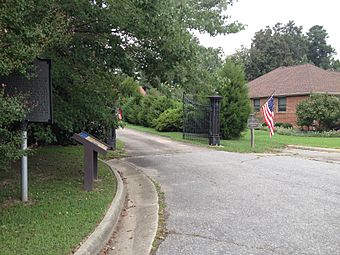Ellerslie (Colonial Heights, Virginia) facts for kids
|
Ellerslie
|
|

Front gate to Ellerslie
|
|
| Location | Ellerslie Rd., Colonial Heights, Virginia |
|---|---|
| Area | 20 acres (8.1 ha) |
| Built | 1857 |
| Built by | Young, Robert |
| Architectural style | Italian Villa |
| NRHP reference No. | 73002206 |
Quick facts for kids Significant dates |
|
| Added to NRHP | December 4, 1973 |
Ellerslie is a historic house located in Colonial Heights, Virginia. It's a large, two-and-a-half-story home built in the Italian Villa style. The house has a cool three-story tower with a sloped roof and a wide front porch.
Contents
A Home with History
Ellerslie has a long and interesting past, starting with a rich tobacco businessman and surviving a war!
The First Ellerslie House
In 1839, a Scottish tobacco businessman named David Dunlop bought a large piece of land. This land was near Swift Creek in Virginia. He built a big house there, which was the first Ellerslie. Sadly, this house was destroyed by a fire in 1856.
Building the New Ellerslie
After the fire, David Dunlop hired an architect named Robert Young. Young was from Belfast, Ireland. He designed a brand new house for Dunlop in 1856. This new house, finished in 1857, was the beautiful Italian Villa style home we see today. It had a flat roof, towers, and fancy castle-like decorations.
Ellerslie During the Civil War
Ellerslie played a big part in the American Civil War. In 1864, it was right in the middle of the Confederate army's defense line.
Battles Around the House
On May 9-10, 1864, there was fighting near Ellerslie. Confederate soldiers fought against a larger Union force. A Confederate cannon battery near the house fired at Union soldiers across the creek. During this battle, a cannonball hit Ellerslie! It stayed stuck in the wall until the house was remodeled many years later.
Confederate soldiers also dug trenches around the mansion. They pushed back Union scouts who came too close. The Union forces eventually retreated.
A General's Headquarters
Later in 1864, Confederate General P. G. T. Beauregard used Ellerslie as his headquarters. This means it was his main office and planning spot.
In April 1865, as the war was ending, there were big fires and explosions near Ellerslie. Supplies and ammunition were burned to keep them from the Union army. This happened as Confederate leaders left Richmond.
A Big Remodel in 1910
In 1910, David Dunlop's grandson, David Dunlop III, decided to update Ellerslie. He hired architects to completely remodel the house.
New Look, Same Structure
The architects kept the main structure and the tower. But they changed the original flat roof to a sloped roof with dormer windows. The inside of the house was also completely redone. All the old wooden details and decorations were replaced. The new style was a mix of popular designs from that time.
Ellerslie's Later Years
The Ellerslie estate stayed in the Dunlop family for many years. It was even used as a dairy farm for a while. The area around Ellerslie became the city of Colonial Heights, Virginia in 1948.
The large dairy barn that was once a local landmark was taken down in the early 1990s. The farmland around the house has since been developed into a shopping center.
Ellerslie was recognized as an important historic place in 1973. It was added to the National Register of Historic Places.
Images for kids




